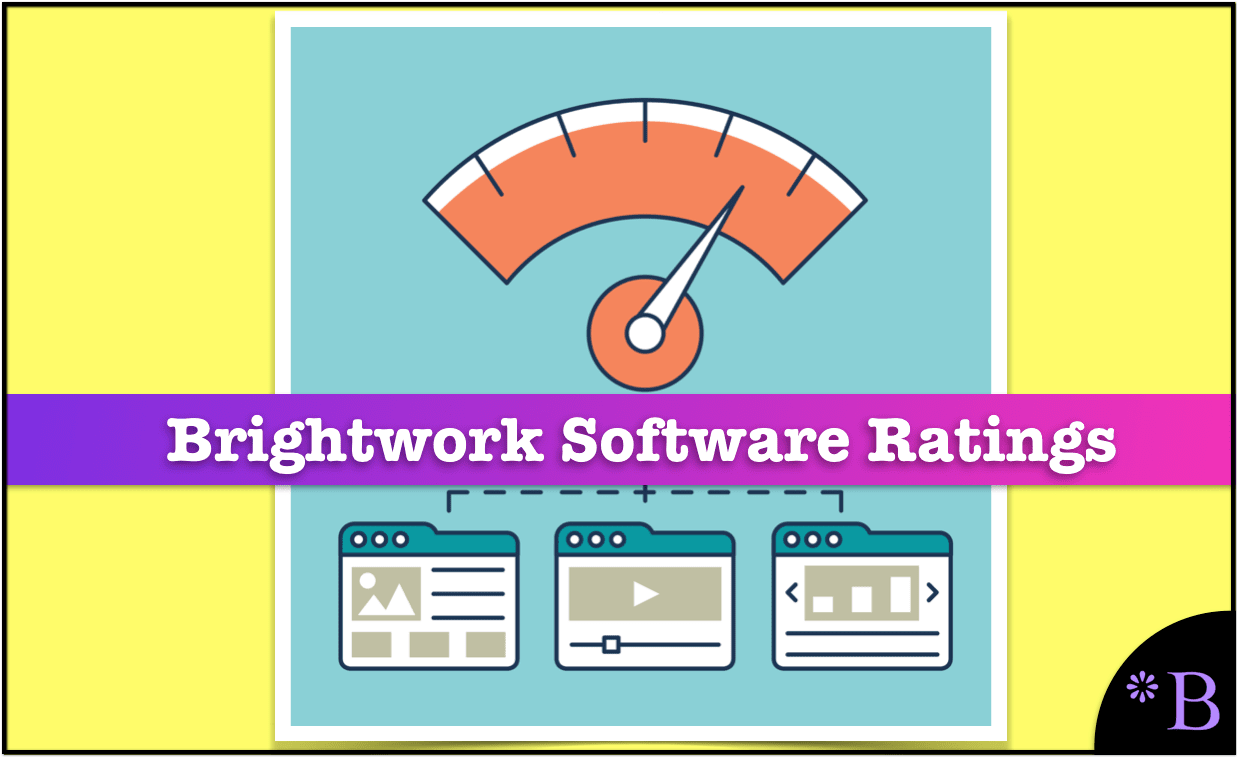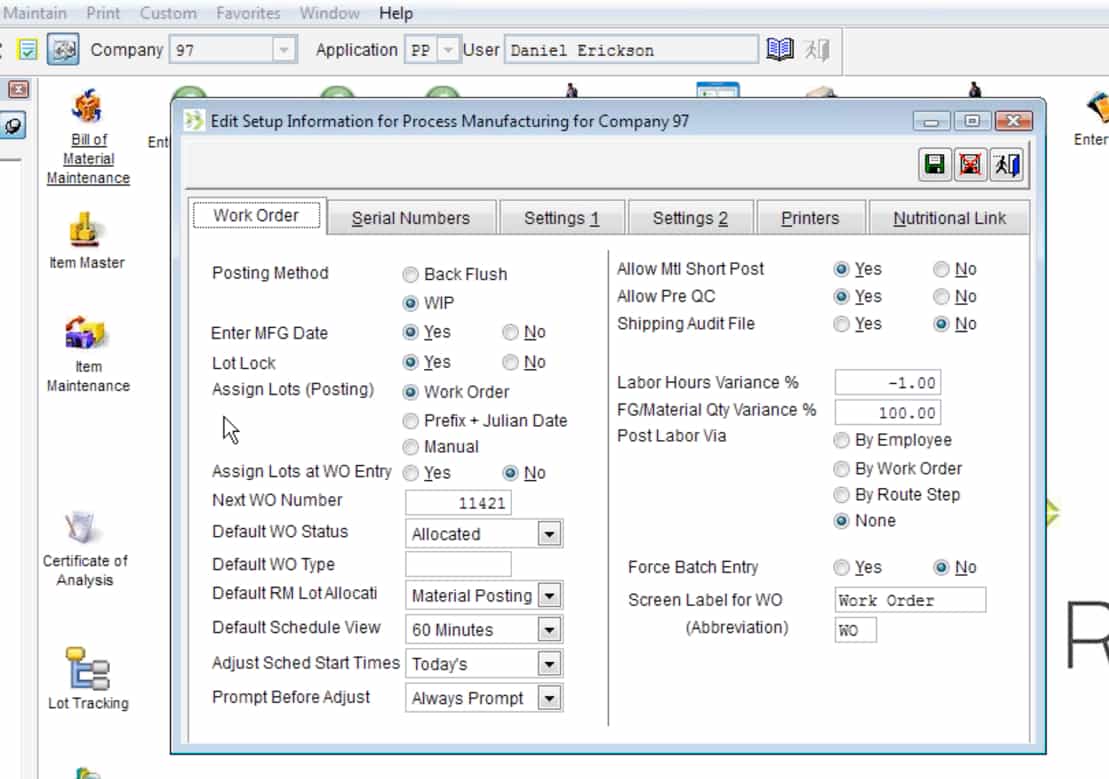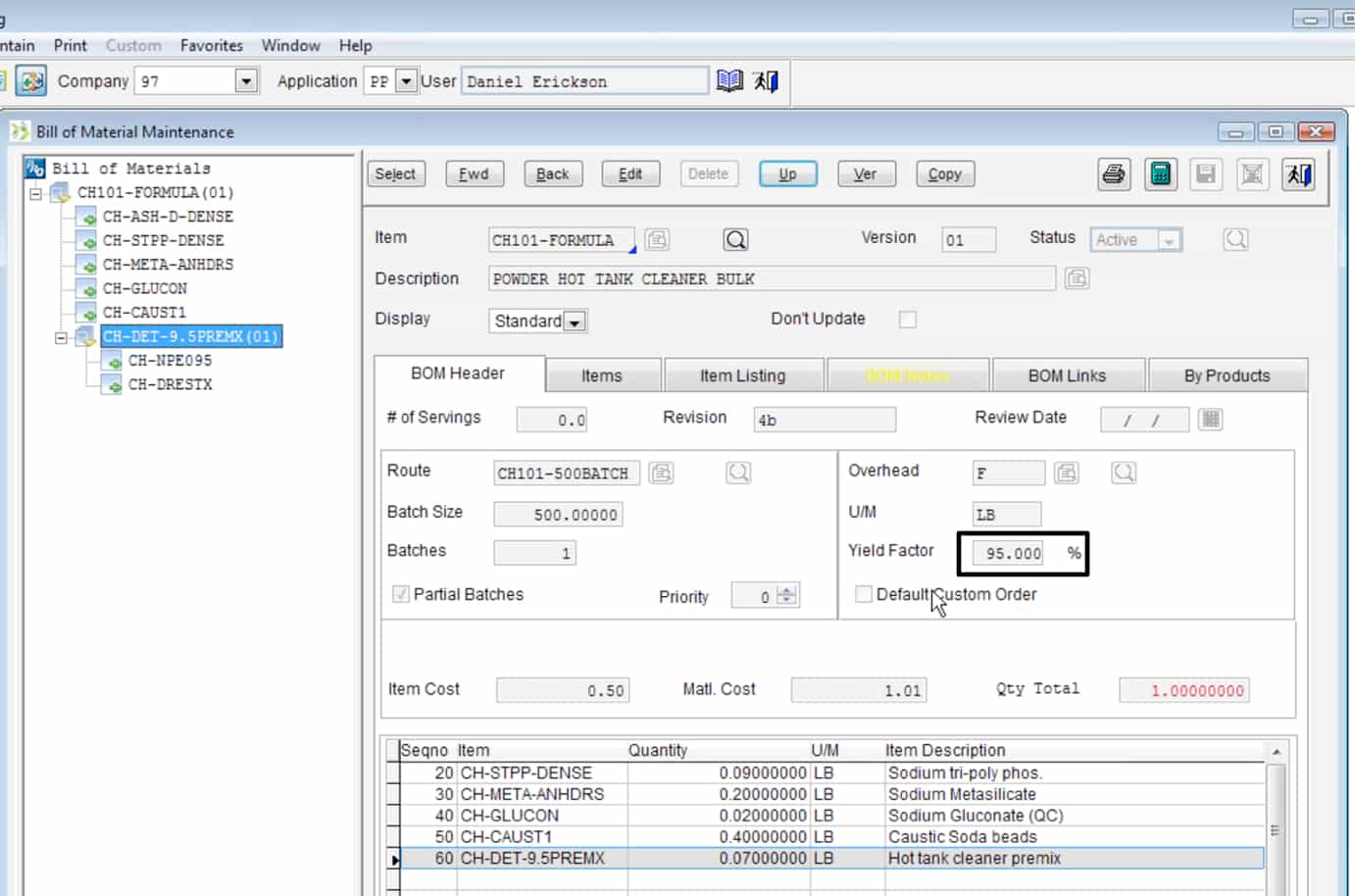Executive Summary
- This is the Brightwork Research & Analysis software rating series.
- We rate both the software and estimate the risk of implementing each application.
MUFI Rating & Risk for ProcessPro
MUFI: Maintainability, Usability, Functionality, Implement ability
Vendor: ProcessPro (Select For Vendor Profile)
Introduction
Process Pro is the ERP company that not many people know about. However, it is our highest rated ERP overall software vendor. Interestingly, Process Pro is not designed to go after the overall ERP market but instead focuses on process industry manufacturing.
What is Process Industry Manufacturing?
Process industry manufacturing is the type of manufacturing environment that manufactures products that cannot be disassembled to their components. The products manufactured by the other types of manufacturing environments—discrete and continuous—can be disassembled. By contrast, the finished product of process manufacturing is not merely the assembly of the input products but is, in fact, an altogether transformed item. For example:
- One cannot unthread fabric to get to the original spools and restock the thread as inventory.
- Once crude oil is cracked into jet fuel, kerosene, tar, etc., it cannot be reconstituted back into crude oil.
- In some types of process industry manufacturing, the input product is literally “gone.” For instance, when coal is converted into electrical energy, it cannot be turned back into coal.
Another standard feature of process industry manufacturing is the number of input products versus the number of output products, which was nicely explained in the quotation below:
“In a discrete environment, many parts are used to make subassemblies, which in turn are put together to make the final product. In other words, many small parts come together to make a product. For example, it takes fifty thousand or more parts to create an automobile.
Process manufacturing is the reverse. A few products or ingredients result in thousands of different products. In plastic manufacturing, ethylene may result in many different products depending upon how it is processed. In semiconductors, a single wafer may result in many different final parts and in food manufacturing, a single ingredient like oranges could result in many products like fresh juice, oranges, dried oranges, frozen juice in different packages and so on.” – Supply Chain Planning for the Process Industry
Application Detail
In process industry manufacturing the following requirements are of great importance to implementation success:
- Partial UOMs
- Parallel UOMs
- Catchweight
- Batch Management/Lot Control
- Recipe and Formula Management
- Assigning Completed Production before QA
- Process Industry Manufacturing Costing
Every other ERP system we have reviewed or tested either does not have any of this functionality or the functionality they do have from this list works either poorly or is very expensive to maintain. For instance, SAP ERP does have batch management functionality, but it is a severe investment whether to enable it. Process Pro has batch management functionality out of the box and ready to use. Within the process industry space, Process Pro is the clear leader in functionality, implement ability, usability, and maintainability. Because of this, it is also the lowest risk implementation ERP system that we cover.
The product is produced in a batch and scheduled on the planning board. The manufacturing batch is then traceable throughout the entire inventory management and sales process. Many customers are pleasantly surprised that it can be done right in the ERP system. Some customers are using spreadsheets to deal will the batch management functionality. Capable batch management functionality in ERP systems is quite. All that is necessary is to denote the common batch size in the master data – and Process Pro functionality will account for it from there on out.
Lot lock disabled connects one lot to one production order – which is, of course, a batch or group of batches. With Lot Lock enabled, the number of lots produced per production order or batch becomes completely adjustable by the production manager. With Lot Lock disabled, it assigns a lot number per posting completion event. Each company will choose how to complete.
ProcessPro uses the term BOM because the company finds it to be more universally understood. However, ProcessPro has both the ability to have fractional input products on the BOM/recipe/formula as well as have multiple output products and incorporate instructions at a header and line level. Therefore it has true recipe/formula management capabilities. In the screenshot, you can see the CH101-Formula has the listed input products. Also, notice that the formula has a yield factor of 95%. This can be adjusted to any value – and copies of formulas that have slight changes in the manufacturing process or the input material can be given different yields to reflect reality.
One of the interesting questions for a manufacturer is whether use ProcessPro’s production scheduling functionality. We recommend a specific application – an advanced planning application for production scheduling, however, ProcessPro has one of the few competent production planning and scheduling systems in any ERP system. The other being Rootstock. It would most likely be effective for a company who’s scheduling problem is not that complex. This could be a nice simplified solution for companies that have this need.
Process industry manufacturing companies have a go-to ERP application in ProcessPro. ProcessPro not only has the software, but they have the vendor attributes to make for a successful implementation and successful long-term support.
MUFI Scores
All scores out of a possible 10.
MUFI Scores
- Ma. = Maintainability
- Us. = Usability
- Fu. = Functionality
- Im. = Implementability
| App | Ma. | Us. | Ft. | Im. | Cat. |
|---|---|---|---|---|---|
| Average Score for Big ERP | 5.1 | 4.8 | 5.2 | 5.4 | Big ERP |
| Average Score for CRM | 6.2 | 6.2 | 5.1 | 5.9 | CRM |
| Average Score for Small and Medium ERP | 8.3 | 8 | 6.7 | 8.5 | Small and Medium ERP |
| Average Score for Finance | 8.8 | 8.8 | 8 | 8.8 | Finance |
| Average Score for Demand Planning | 7.6 | 7.2 | 7 | 7.1 | Demand Planning |
| Average Score for Supply Planning | 6.7 | 6.9 | 7 | 6.8 | Supply Planning |
| Average Score for Production Planning | 6.8 | 6.9 | 7 | 6.9 | Production Planning |
| Average Score for BI Heavy | 5.5 | 5.3 | 6.9 | 5.3 | BI Heavy |
| Average Score for PLM | 7 | 7.2 | 6.8 | 7.3 | PLM |
| Average Score for BI Light | 7.7 | 8.7 | 9 | 8.3 | BI Light |
| Arena Solutions Arena PLM | 10 | 10 | 10 | 10 | PLM |
| AspenTech AspenOne | 4 | 8 | 10 | 7 | Production Planning |
| Birst | 8 | 8.5 | 10 | 8 | BI Light |
| ERPNext | 10 | 10 | 7.5 | 10 | Small and Medium ERP |
| Delfoi Planner | 8 | 6 | 6.5 | 7 | Production Planning |
| Demand Works Smoothie SP | 9 | 10 | 7 | 10 | Supply Planning |
| Hamilton Grant RM | 10 | 9 | 8.5 | 9 | PLM |
| IBM Cognos | 2.7 | 3 | 1.5 | 3 | BI Heavy |
| Infor Epiphany | 7 | 8 | 6 | 5 | CRM |
| Infor Lawson | 8 | 7 | 6 | 7 | Big ERP |
| Intuit QuickBooks Enterprise Solutions | 9 | 9 | 5 | 9 | Finance |
| JDA DM | 9 | 7.5 | 8 | 8 | Demand Planning |
| Microsoft Dynamics CRM | 2 | 3 | 2 | 2 | CRM |
| NetSuite CRM | 6 | 4 | 3 | 3 | CRM |
| Netsuite OneWorld | 7 | 7 | 8 | 8 | Big ERP |
| OpenERP | 7 | 8 | 8.5 | 8 | 7 |
| Oracle BI | 4 | 4 | 3 | 6 | BI Heavy |
| Oracle CRM On Demand | 4 | 5 | 3 | 5 | CRM |
| Oracle Demantra | 5 | 3 | 3.5 | 4.5 | Demand Planning |
| Oracle JD Edwards World | 4 | 1 | 3 | 6 | Big ERP |
| Oracle RightNow | 6 | 7 | 4 | 5 | CRM |
| PlanetTogether Galaxy APS | 10 | 10 | 10 | 10 | Production Planning |
| Preactor | 8 | 7 | 3 | 7 | Production Planning |
| QlikTech QlikView | 9 | 9 | 10 | 9 | BI Light |
| Rootstock | 9 | 8 | 9 | 9 | Small and Medium ERP |
| Sage X3 | 8 | 8 | 7 | 8 | Big ERP |
| Salesforce Enterprise | 8 | 8.5 | 9 | 7.5 | CRM |
| SAP APO DP | 3 | 4 | 3 | 2 | Demand Planning |
| SAP APO PP/DS | 2 | 2 | 4 | 3 | Production Planning |
| SAP APO SNP | 3 | 4 | 8 | 4 | Supply Planning |
| SAP BI/BW | 1.5 | 2 | 4 | 2 | BI Heavy |
| SAP Business Objects | 3 | 2.5 | 7 | 3 | BI Heavy |
| SAP CRM | 4 | 3 | 6 | 4 | CRM |
| SAP ECC | 3 | 3 | 6.5 | 3 | Big ERP |
| SAP PLM | 1 | 2.5 | 2 | 3 | PLM |
| SAP SmartOps | 4 | 4 | 7 | 5.5 | Supply Planning |
| SAS BI | 6.5 | 7 | 9 | 6 | BI Heavy |
| SAS Demand Driven Forecasting | 7 | 8 | 9 | 7 | Demand Planning |
| Tableau (BI) | 9 | 10 | 10 | 10 | BI Light |
| Tableau (Forecasting) | 10 | 8 | 5 | 9 | Demand Planning |
| Teradata | 8 | 6.3 | 9.7 | 6 | BI Heavy |
| ToolsGroup SO99 (Forecasting) | 7 | 8 | 9 | 7 | Demand Planning |
| ToolsGroup SO99 (Supply) | 5 | 6 | 10 | 7 | Supply Planning |
Vendor and Application Risk
*ProcessPro does not sell its application outside of the process industry; therefore our comments will reflect this assumption.
Any buyer that implements ProcessPro starts off their implementation with a huge leg up. The lifecycle of most application implementations in the process industry is that the sales team for the software vendor overstate the actual process industry functionality within the application. The implementation begins, and the rest of the implementation is a slow-motion car wreck as one after another process industry functionality turns out to be far less than advertised. Numerous software vendors are responsible for continually overstating their process industry functionality. ProcessPro combines real process industry functionality with a highly implementable application. Configuration is straightforward, transparent and easy to troubleshoot – something, which are common shortcomings with ERP systems.
Likelihood of Implementation Success
This accounts for both the application and vendor-specific risk. In our formula, the total implementation risk is application + vendor + buyer risk. The buyer specific risk could increase or decrease this overall likelihood and adjust the values that you see below.
Likelihood of Application Implementation Success and Failure
Search for the application in this table using the search bar in the upper right of the table.
| Application | Prob of Implementation Success | Prob of Implementation Failure |
|---|---|---|
| Actuate | 0.77 | 0.23 |
| SAP Smartops | 0.39 | 0.61 |
| NetSuite CRM | 0.46 | 0.54 |
| Sugar CRM | 0.62 | 0.48 |
| Base CRM | 0.91 | 0.09 |
| SAP CRM | 0.35 | 0.65 |
| Salesforce Enterprise | 0.72 | 0.28 |
| QlikTech QlikView | 0.82 | 0.18 |
| Tableau (BI) | 0.98 | 0.02 |
| SAP Crystal Reports | 0.46 | 0.54 |
| Brist | 0.83 | 0.17 |
| MicroStrategy | 0.7 | 0.3 |
| SAS BI | 0.76 | 0.24 |
| Oracle BI | 0.35 | 0.65 |
| IBM Cognos | 0.23 | 0.77 |
| Infor Epiphany | 0.58 | 0.42 |
| Microsoft Dynamics CRM | 0.26 | 0.74 |
| Oracle RightNow CRM | 0.41 | 0.59 |
| Oracle CRM On Demand | 0.36 | 0.64 |
| Teradata | 0.76 | 0.24 |
| SAP Business Objects | 0.32 | 0.68 |
| SAP BI/BW | 0.25 | 0.75 |
| SAP PLM | 0.29 | 0.71 |
| Hamilton Grant RM | 0.89 | 0.11 |
| Arena Solutions | 0.96 | 0.04 |
| Delfoi Planner | 0.7 | 0.3 |
| Preactor | 0.64 | 0.36 |
| PlanetTogether Galaxy APS | 0.96 | 0.04 |
| AspenTech AspenOne | 0.55 | 0.45 |
| SAP APO PP/DS | 0.27 | 0.73 |
| Demand Works Smoothie SP | 0.93 | 0.07 |
| ToolsGroup SO99 (Supply) | 0.82 | 0.18 |
| Demand Works Smoothie | 0.96 | 0.04 |
| Tableau (Forecasting) | 0.9 | 0.1 |
| SAS Demand Driven Forecasting | 0.82 | 0.18 |
| ToolsGroup SO99 (Forecasting) | 0.86 | 0.14 |
| JDA DM | 0.57 | 0.43 |
| Oracle Demantra | 0.33 | 0.67 |
| SAP APO DP | 0.28 | 0.72 |
| FinancialForce | 0.92 | 0.08 |
| Intacct | 0.98 | 0.02 |
| Intuit QB Enterprise | 0.8 | 0.2 |
| ERPNext | 0.9 | 0.1 |
| OpenERP | 0.78 | 0.22 |
| Rootstock | 0.91 | 0.09 |
| ProcessPro | 0.93 | 0.07 |
| Microsoft Dynamics AX | 0.4 | 0.6 |
| SAP Business One | 0.49 | 0.51 |
| Sage X3 | 0.62 | 0.38 |
| Infor Lawson | 0.58 | 0.42 |
| Epicor ERP | 0.4 | 0.6 |
| Oracle JD Edwards World | 0.31 | 0.69 |
| Oracle JD Edwards EnterpriseOne | 0.36 | 0.64 |
| SAP ERP ECC/R/3 | 0.32 | 0.68 |
| NetSuite OneWorld | 0.65 | 0.35 |
Risk Definition
See this link for more on our categorizations of risk. We also offer a Buyer Specific Risk Estimation as a service for those that want a comprehensive analysis.
Risk Management Approach
There is not much that is specific to ProcessPro, either the application or the software vendor when it comes to risk management of a ProcessPro implementation. Buyers have many factors working in their favor on ProcessPro deployments – but the biggest is that the promised process industry ERP functionalities work.
Finished With Your Analysis?
To go back to the Software Selection Package page for the Small and Medium ERP software category. Or go to this link to see other analytical products for ProcessPro.



